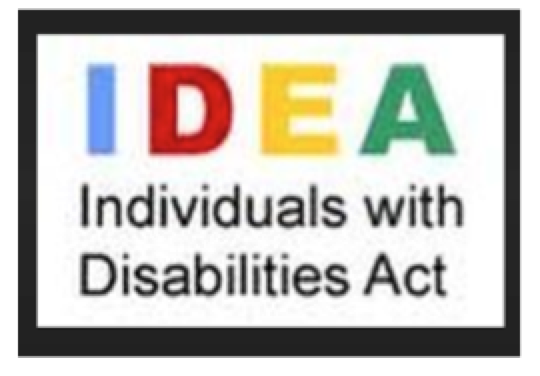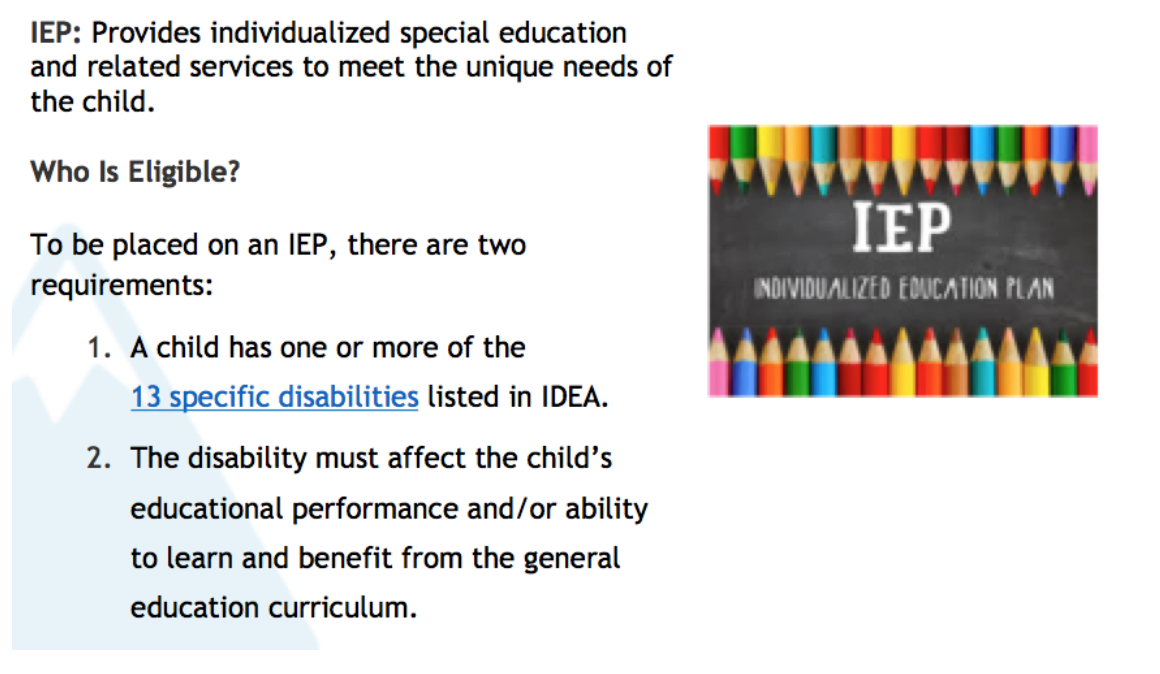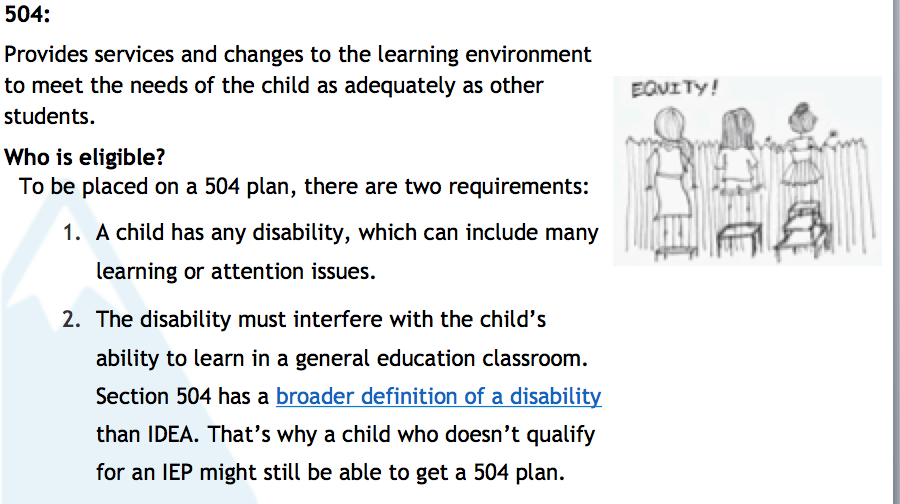Lesson 5: Building on a Foundation 2e Learners
| Site: | Colorado Education Learning Management System |
| Course: | 2e (Open Access) Supporting Twice Exceptional Learners |
| Book: | Lesson 5: Building on a Foundation 2e Learners |
| Printed by: | Guest user |
| Date: | Saturday, 6 December 2025, 8:47 PM |
Description
Lesson 1: Building a Foundation
What 2e Students Want you to Know
The purpose of this course is to inspire you to make a difference in the lives of 2e students and to start you on your journey to gathering the information and building the skills you need. Begin by watching this 1:52 minute video of 2e children, "
Special Education Laws & 2e
Our goal in this class is to build upon what you learned about twice-exceptional students in the Part 1 course. As you recall, or know from your own gifted education experience, twice exceptional (2e) isn't a label you put on any official form. It is, however, defined in Colorado state law, 12.01.(30). Not just twice-exceptional students, but all gifted students are considered "exceptional children," as are children with disabilities, and Colorado laws that apply to these populations are found in the Exceptional Children's Education Act 1 CCR 301-8. (Gifted Education law begins on page 103 in the document and page 110 in the top PDF pages.)
In everyday language, twice-exceptional is defined as being gifted and qualifying for an IEP or 504 plan. In this course, we continue to delve deeper into understanding and supporting our 2e learners by examining the most common disabilities among the 2e population: autism spectrum disorder (ASD), specific learning disability (SLD), other health impairments (OHI) -- specifically attention deficit hyperactivity disorder (ADHD).
The three primary federal laws that apply to the 2e population are:
1. The Individuals with Disabilities Education Act ("the IDEA");
2. Section 504 of the Rehabilitation Act of 1973 (Section 504);
3. Title II of the ADA Amendments Act of 2008 ("Title II" or "the ADA").
It is important to emphasize that Colorado is a local-control state, which means, that decisions about implementation and procedures to fulfill legal requirements are made locally; for example, districts are legally required to have an assessment process to identify gifted students, but that process will vary in different districts.
Remember to use the horizontal arrows or chapter menu to the right to proceed through the course to get to all the pages in Lesson 1.
IDEA

The Individuals with Disabilities Education Act (IDEA) is
our nation's special education law and it requires schools to serve the
educational needs of eligible students with disabilities.
IDEA makes a free appropriate public education (FAPE)
available to eligible children with disabilities in every state and ensures
special education and related services to those children.
IDEA governs how states and public agencies provide early
intervention, special education, and related services to more than 6.5 million
eligible infants, toddlers, children, and youth with disabilities.
Infants and toddlers with disabilities (birth-2) and their
families receive early intervention services under IDEA Part C. Children and youth (ages 3-21) receive
special education and related services under IDEA Part B.
For further information, visit U.S. Department of Education:
Individuals with Disabilities Act About IDEA (optional).
Exceptional Children's Educational Act (ECEA)
Each state must follow IDEA, but may also create additional laws and rules. In Colorado, the Rules for the Administration of the ECEA outline specific requirements regarding how IDEA and special education are to be implemented across the state.
- Rules for the Administration of the ECEA - Effective March 1, 2016 (PDF) -- Optional Resource
Child Find
Child Find is part of IDEA.
The Child Find mandate is a legal requirement that requires school
districts to have a process for identifying and evaluating children who may
need special education or related service, i.e., counseling or speech therapy (“Child Find: What it is and how it works,” Understood.org). In brief, there are 3 big ideas you need to
know as an educator/specialist/administrator about Child Find:
- All children from birth to age 21 are covered, including infants, toddlers and children who are homeschooled or in private school.
- Child Find does not require schools to agree to evaluate every child.
- If a school refuses to evaluate a child, parents may challenge that decision.
"In Colorado, Child Find is often associated with
children who are not yet school age (i.e., birth to five years old). However,
the mandate remains once the child is in school, most often starting in
kindergarten, and remains until the child ages out of eligibility for special
education services at 21 years old. Importantly, the responsibility often
shifts from a district or BOCES run child find program to the school the child
attends or is zoned to attend once the child is kindergarten age" (Chris Miller, CDE).
Factors that may trigger a Child Find duty include:
(Kathryn Newell, 2021 Virtual Special Education Legal Conference, see Resource folder for PDF of presentation)
- Evidence of poor grades
- Evidence of behavior problems
- Evidence of attendance problems
- Information about a child’s medical diagnosis
- Concerns expressed by a teacher or other staff member
- Concerns expressed by a parent
- Evidence that a child’s Multi-Tiered Systems of Support (MTSS) plan or Section 504 Plan is not meeting their needs
- Parents do not have to wait for a school district to initiate the evaluation process. They can request a special education evaluation at any time.
- A parent’s request for a special
education evaluation triggers the school district’s
requirement to provide prior written notice (PWN).
- Child Find is an ongoing obligation. There may be a need to reevaluate a child who was previously considered ineligible for an IEP.
Colorado Department of Education (CDE) provides guidance on finding children from birth to 5. See: Early Child Find. Evaluations conducted by Colorado Child Find teams are at no cost to parents. Children who are not yet in kindergarten may be referred at any time when a family member, doctor, or child care provider has a concern about their development.
Individualized Education Plans (IEP) and 504 Plans
Students identified with a disability must have an individualized education plan (IEP). Following this plan is required. As you can see in the graphic below, to qualify for an IEP, a child must have one of 13 specific disabilities, and the disability must affect the child's ability to learn in the general education setting.

Because of their ability to compensate, and therefore, not fall behind in grade-level standards, 2e students often do not qualify for an IEP (unless their disability is physical, not a learning difference, such as dyslexia), but they still require accommodations or modifications. If a student has learning or attention issues and is struggling in school, and doesn’t qualify for an Individualized Education Program (IEP), a Section 504 plan may be a good alternative. This is especially true if the student already receives informal supports. Check with your administration about the process for qualifying students for 504 plans since districts/schools handle this process differently.
"Section 504's child find requirement is slightly broader than the IDEA's child find provision. While the IDEA only requires districts to identify and evaluate students suspected of needing special education because of a disability, Section 504 requires a district to identify and evaluate any student suspected of having a disability and needing special education or related services as a result" (Slater, 2020, p.8).

What is a Section 504 plan?
This type of plan falls under Section 504 of the Rehabilitation Act of 1973. Section 504 is the part of the federal civil rights law that prohibits discrimination against people with disabilities in programs that receive federal financial assistance, such as public schools. This includes students with disabilities such as learning and attention issues who meet certain criteria.
Much like an IEP, a Section 504 plan, or "504 plan," can help students with learning and attention issues learn and participate in the general education curriculum. A 504 plan outlines how a child’s specific needs are met with accommodations, modifications, and other services. These measures “remove barriers” to learning.
Section 504 states that: “No otherwise qualified individual with a disability in the United States, as defined in section 706(8) of this title, shall, solely by reason of her or his disability, be excluded from the participation in, be denied the benefits of, or be subjected to discrimination under any program or activity receiving Federal financial assistance…” [29 U.S.C. §794(a), 34 C.F.R. §104.4(a)].
What is an impairment under Section 504?
An impairment as used in Section 504 may include any disability, long-term illness, or various disorders that “substantially” reduces or lessens a student’s ability to access learning in the educational setting because of a learning-behavior or health-related condition.Keep in mind that a student with a 504 plan usually spends the entire school day in a general education classroom. Typically, children who need modifications would have an IEP, instead of a 504 plan.
For more information on Section 504 plans, visit the following website (optional resource)
Identification of 2e Students
In Part 1 of the course, we went into some detail about the challenges involved with identifying 2e learning and the process of gifted identification. Even though it can be complicated, it is important to understand the legal requirements around identifying our 2e students.
Assessing Students Identified with a Disability for Gifted Services
Section 504 and the ADA prohibit discrimination against students on the basis of a disability. This means that students with disabilities should have equal opportunity to participate in assessments for gifted programs (Slater, 2020, Educating Twice-Exceptional Students in Compliance with IDEA and Section 504). Since many recommendations come from teachers, they must be familiar with the characteristics of gifted learners as well as a general understanding of 2e.
Assessing Students Identified as Gifted for IDEA or Section 504 Services
Educators may also fail to refer students who are already identified as gifted for disability identification. While most educators are aware that IDEA requires us to find, evaluate, and identify students suspected of having a learning disability, they may decline to refer an academically gifted student...based on the mistaken belief that high-achieving students are ineligible for such services. Others may focus on a student's passing grades or appropriate classroom behavior without realizing the amount of effort required to maintain that level of performance….[or] may not realize how a student's giftedness can mask his disability (or vice versa). (Slater, 2020, p. 5)
Slater (2020) also notes common barriers that are preventing educators from referring gifted students who may need special education services:
- Educator mindset - educators may not understand that a student can be cognitively advanced and also have a disability.
- Confusion about legal requirements
- Difficulties spotting signs of disability in gifted students (masking)
As Slater emphasizes, "It's clear that gifted students fall within the scope of the IDEA's child find requirement" (p. 5).
As you know from the Part 1 course, identifying 2e students can be difficult, but it is legally required. Steps your district or school can take are:
- Review child find obligations with all relevant staff. https://www.cde.state.co.us/cdesped/sd-sld_resources_eligibility_guidance
- Ensure that all evaluators are knowledgeable about twice-exceptional students. https://www.cde.state.co.us/gt/twice-exceptional
- Learn state requirements for gifted programs. https://www.cde.state.co.us/gt (credit: Slater, 2020, p. 13)
Discussion Board Activity
Click HERE or go back to the course's main page to complete the discussion board activity.
Post your response to the question and respond to at least two other posts.
